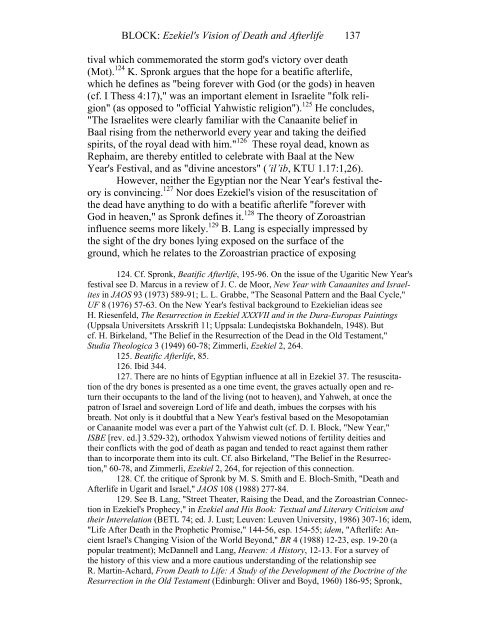Beyond the Grave - Institute for Biblical Research
Beyond the Grave - Institute for Biblical Research
Beyond the Grave - Institute for Biblical Research
Create successful ePaper yourself
Turn your PDF publications into a flip-book with our unique Google optimized e-Paper software.
BLOCK: Ezekiel's Vision of Death and Afterlife 137<br />
tival which commemorated <strong>the</strong> storm god's victory over death<br />
(Mot). 124 K. Spronk argues that <strong>the</strong> hope <strong>for</strong> a beatific afterlife,<br />
which he defines as "being <strong>for</strong>ever with God (or <strong>the</strong> gods) in heaven<br />
(cf. I Thess 4:17)," was an important element in Israelite "folk reli-<br />
gion" (as opposed to "official Yahwistic religion"). 125 He concludes,<br />
"The Israelites were clearly familiar with <strong>the</strong> Canaanite belief in<br />
Baal rising from <strong>the</strong> ne<strong>the</strong>rworld every year and taking <strong>the</strong> deified<br />
spirits, of <strong>the</strong> royal dead with him." 126 These royal dead, known as<br />
Rephaim, are <strong>the</strong>reby entitled to celebrate with Baal at <strong>the</strong> New<br />
Year's Festival, and as "divine ancestors" (’il’ib, KTU 1.17:1,26).<br />
However, nei<strong>the</strong>r <strong>the</strong> Egyptian nor <strong>the</strong> Near Year's festival <strong>the</strong>-<br />
ory is convincing. 127 Nor does Ezekiel's vision of <strong>the</strong> resuscitation of<br />
<strong>the</strong> dead have anything to do with a beatific afterlife "<strong>for</strong>ever with<br />
God in heaven," as Spronk defines it. 128 The <strong>the</strong>ory of Zoroastrian<br />
influence seems more likely. 129 B. Lang is especially impressed by<br />
<strong>the</strong> sight of <strong>the</strong> dry bones lying exposed on <strong>the</strong> surface of <strong>the</strong><br />
ground, which he relates to <strong>the</strong> Zoroastrian practice of exposing<br />
124. Cf. Spronk, Beatific Afterlife, 195-96. On <strong>the</strong> issue of <strong>the</strong> Ugaritic New Year's<br />
festival see D. Marcus in a review of J. C. de Moor, New Year with Canaanites and Israel-<br />
ites in JAOS 93 (1973) 589-91; L. L. Grabbe, "The Seasonal Pattern and <strong>the</strong> Baal Cycle,"<br />
UF 8 (1976) 57-63. On <strong>the</strong> New Year's festival background to Ezekielian ideas see<br />
H. Riesenfeld, The Resurrection in Ezekiel XXXVII and in <strong>the</strong> Dura-Europas Paintings<br />
(Uppsala Universitets Arsskrift 11; Uppsala: Lundeqistska Bokhandeln, 1948). But<br />
cf. H. Birkeland, "The Belief in <strong>the</strong> Resurrection of <strong>the</strong> Dead in <strong>the</strong> Old Testament,"<br />
Studia Theologica 3 (1949) 60-78; Zimmerli, Ezekiel 2, 264.<br />
125. Beatific Afterlife, 85.<br />
126. Ibid 344.<br />
127. There are no hints of Egyptian influence at all in Ezekiel 37. The resuscita-<br />
tion of <strong>the</strong> dry bones is presented as a one time event, <strong>the</strong> graves actually open and re-<br />
turn <strong>the</strong>ir occupants to <strong>the</strong> land of <strong>the</strong> living (not to heaven), and Yahweh, at once <strong>the</strong><br />
patron of Israel and sovereign Lord of life and death, imbues <strong>the</strong> corpses with his<br />
breath. Not only is it doubtful that a New Year's festival based on <strong>the</strong> Mesopotamian<br />
or Canaanite model was ever a part of <strong>the</strong> Yahwist cult (cf. D. I. Block, "New Year,"<br />
ISBE [rev. ed.] 3.529-32), orthodox Yahwism viewed notions of fertility deities and<br />
<strong>the</strong>ir conflicts with <strong>the</strong> god of death as pagan and tended to react against <strong>the</strong>m ra<strong>the</strong>r<br />
than to incorporate <strong>the</strong>m into its cult. Cf. also Birkeland, "The Belief in <strong>the</strong> Resurrec-<br />
tion," 60-78, and Zimmerli, Ezekiel 2, 264, <strong>for</strong> rejection of this connection.<br />
128. Cf. <strong>the</strong> critique of Spronk by M. S. Smith and E. Bloch-Smith, "Death and<br />
Afterlife in Ugarit and Israel," JAOS 108 (1988) 277-84.<br />
129. See B. Lang, "Street Theater, Raising <strong>the</strong> Dead, and <strong>the</strong> Zoroastrian Connec-<br />
tion in Ezekiel's Prophecy," in Ezekiel and His Book: Textual and Literary Criticism and<br />
<strong>the</strong>ir Interrelation (BETL 74; ed. J. Lust; Leuven: Leuven University, 1986) 307-16; idem,<br />
"Life After Death in <strong>the</strong> Prophetic Promise," 144-56, esp. 154-55; idem, "Afterlife: An-<br />
cient Israel's Changing Vision of <strong>the</strong> World <strong>Beyond</strong>," BR 4 (1988) 12-23, esp. 19-20 (a<br />
popular treatment); McDannell and Lang, Heaven: A History, 12-13. For a survey of<br />
<strong>the</strong> history of this view and a more cautious understanding of <strong>the</strong> relationship see<br />
R. Martin-Achard, From Death to Life: A Study of <strong>the</strong> Development of <strong>the</strong> Doctrine of <strong>the</strong><br />
Resurrection in <strong>the</strong> Old Testament (Edinburgh: Oliver and Boyd, 1960) 186-95; Spronk,

















